The night bus from Tokyo dropped me off in front of Kyoto station early in the morning. As nothing was open yet, and the city buses were not running, I explored Kyoto station. The entire station is covered by an undulating glass canopy, under which lies not only the station building but a park built on the rooftops of the station as in stair-steps its way from the ground floor to the 11th floor. There is an open viewing platform at the top with nice views of the city.
 |
| Kyoto station schematic. |
When the buses started running I hopped on bus 26 to perhaps my favourite hostel in the world, the
Utano Youth Hostel in northwestern Kyoto. It's a long ride to the Utano—almost one hour—but the bus drops you off right next to the hostel and you don't have to make any transfers so it's not that bad.
Utano is the second-last stop for Bus 26, "Youth Hostel Mae." After getting off at the Youth
Hostel stop, simply cross the road and walk up the street leading north;
the hostel will be the first building on your left.
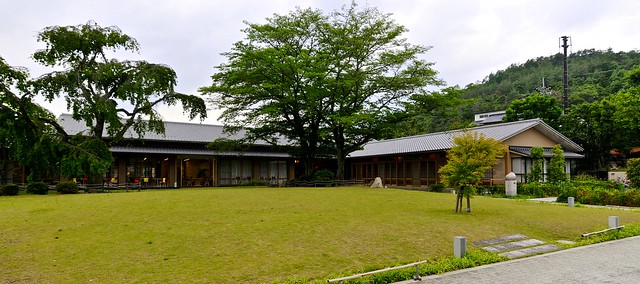 |
Front of the Utano hostel.
|
Kyoto: the best of Japan
Kyoto is one of my favourite cities in
the world. It has the best of everything Japan has to offer: natural
beauty, historical temples and shrines, traditional streets, modern
conveniences, and good food.
Although many of the
sights were built because of Kyoto's status as the traditional capital
of Japan (Kyoto's kanji means "Capital City," while Edo adopted the name of Tokyo, or "Eastern Capital," when the seat of power moved), their
survival is the result of a conscious decision by the U.S. not to subject Kyoto to the same firebombing campaigns that ravaged other Japanese cities like Tokyo.
The combination of history and immunity from destruction makes the
preservation of old Kyoto unique in Japan.
This means that not only are superstar attractions like Kiyomizudera, Kinkakuji, Ryoanji, Ginkakuji, and Heian shrine preserved, but hundreds of smaller, quieter, and more contemplative temples and shrines also emerged from the war unscathed. And, for me, it is in these smaller and quieter places that Japan is at its contemplative best.
With a few notable exceptions (Nijo Castle, the Imperial Palace, and the zen temple complexes), the most interesting sights in Kyoto line the edges of the mountains. This means that the sights essentially ring the city, with the eastern mountains of Higashiyama having the numerical advantage, the northwestern slopes featuring Kinkakuji, Ryoanji, and Ninnaji, and the eastern district of Arashiyama also featuring a number of temples on its slopes. These mountainous settings help contribute to the quiet, rural tranquility of the city.
Utano youth hostel: spectacular and mediocre at the same time
The Utano hostel is only a few years old, and the new buildings are gorgeous and were clearly designed to echo traditional Japan. Unlike most hostels and hotels, the hostel's semi-rural location means that space is not at a premium, and the hostel is only two stories high, and basically forms a ring of outward-facing rooms around an inner hallway that looks onto a large interior grassy courtyard. All rooms have a small balcony the looks out on the neighboring forest.
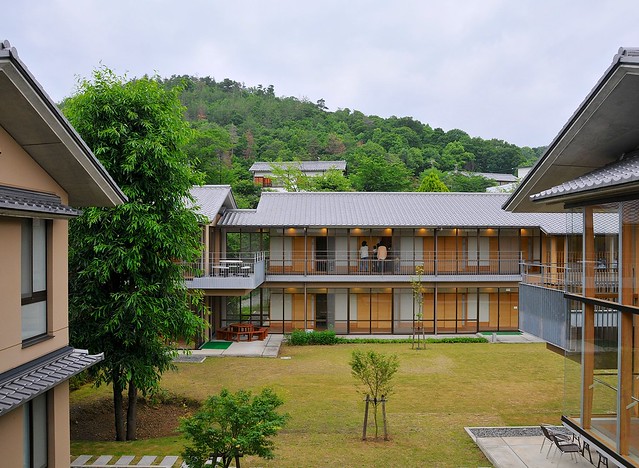 |
The Utano courtyard, looking north.
|
Bathrooms are shared, and although there are traditional Japanese-style O-furo communal baths, there are also private showers should you so desire (I decided to forego the communal bathing at the last minute after a Japanese father brought his toddler daughter into the men's bath—while this may be normal for Japanese, it was pushing things a bit for me).
As a large hostel with a lot of rooms, the hostel hosts a lot of large groups and Japanese schoolkids, which means it's not a great place to meet other solo travelers or even those traveling independently. And because there are a lot of schoolkids, it can get noisy. The noise problem isn't helped by the decision to use sliding wood doors for all rooms, as these doors slide somewhat noisily and leak a lot of hallway noise into the rooms. Since the hostel caters mainly to Japanese customers, the English spoken by employees is highly variable and surprisingly bad compared to what you typically see at much smaller private hostels.
The hostel is also overpriced, as a single dorm bed will cost you almost ¥4,000. This is almost double what many private hostels will charge, and if you're traveling as a couple and order breakfast it will be cheaper to visit a
Toyoko Inn. Heck, most
minshuku are cheaper, regardless of how many people are traveling, and I would seriously consider the nearby
Ryokan Yamazaki for about the same price. For slightly more, you can even
stay at Ninnaji (which will also get you free admission to the palace area).
So, with all these downsides, why do I like Utano so much? The location and setting. Waking up in a beautiful, elegant, and tranquil building is a great way to start the day. And if you start your day with a walk to the nearest sight—whether east to Ninnaji or west to Hirosawa pond and Arashiyama—you're ensuring you're going to be in a great frame of mind. Staying in Utano and spending the day in Arashiyama is a difficult experience to match.
Of course, this praise only works if you prioritize
tranquility, natural scenery and quiet old buildings
and temples. If you like nightlife
and bustle, you're probably not going to enjoy how far away you are from the city center and the entertainment districts. It's for this reason that I think the best way to experience Kyoto is to spend a couple of days at Utano and a couple of days at a more central location from where you can experience Higashiyama and central Kyoto.
You can also rent bicycles from the hostel, which is a great way to get around.
Two days in Utano
If you have two days in Utano, here are a couple of suggested itineraries.
I take some variation on the first one every time I visit Kyoto. It's a beautiful walk west from Utano, and you don't really see many tourists until you start descending the bamboo path. Before then, however, you'll be able to walk through farmers' fields, past beautiful ponds, along quaint streets lined with traditional buildings and small teahouses, past a handful of hillside temples, and through a park overlooking Arashiyama mountain and Hozugawa river. This route is quite walkable, and a bike isn't always the best as the roads are mainly for pedestrians and you'll be stopping frequently. Japan Guide has a nice summary of the main sights
here.
The following is a much more ambitious route, and will likely require an early start and a long day, depending on how many of the temples and shrines you see and how long you stay at each. You will definitely need a bike for this route,which can be rented from the Utano hostel.
Realistically, I think you can make it to Entsuji before it closes at 4:30, especially if you don't see too many sub-temples at Daikakuji. After Entsuji there are no real closing times, except for places at the Imperial Palace, where you'll only be able to see the grounds.
Day one from Utano: Ninnaji, Myoshinji, and Gion
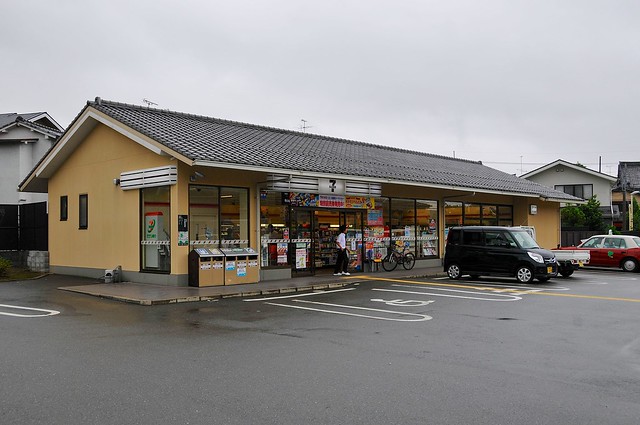 |
| One of my favourite 7-Elevens (yes, I have favourites), just around
the corner from Ninnaji. As a nod to the location, the logo is
monochrome. Combini, or convenience stores, are a feature of Japan, and 7-Eleven is now a Japanese-owned company with over 16,000 stores in Japan (compared to less than 8,000 in the U.S.A.). Fixed Japanese pricing structures means that products cost virtually the same in a combini as they do in a supermarket, and you can also pay your utilities and bills in combini, too. Unfortunately, they don't have Slurpees. |
Ninnaji
Ninnaji is a large temple complex, with multiple buildings spread around a verdant, tree-filled compound. It feels very much like a park. Admission to the main grounds is free, but the separate gardens and buildings associated with the palace carry a ¥500 admission fee. Although admission fees at all temples are fairly reasonable, they can definitely add up, and at some point you're going to have to make decisions based on admission costs.
 |
| Just inside the entrance to Ninnaji. The admission-carrying Goten area is to the left. |
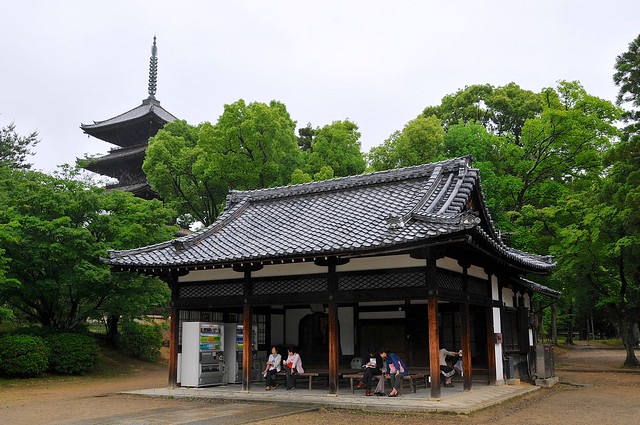 |
| Possibly the classiest refreshment pavilion I've ever seen. |
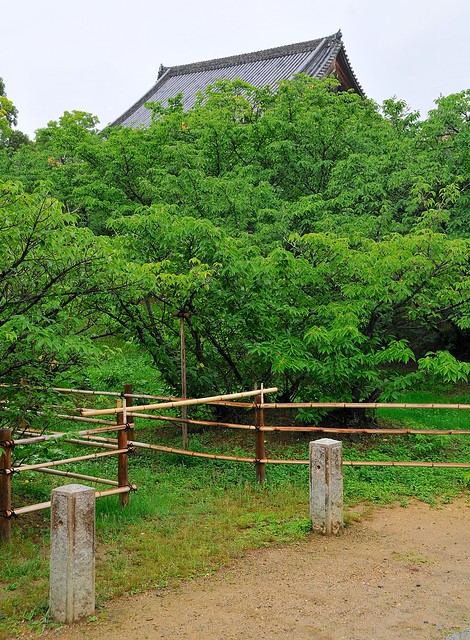 |
| Ninnaji is strewn with temple buildings. |
 |
| Pagoda and temple. |
 |
| Moss and trees. |
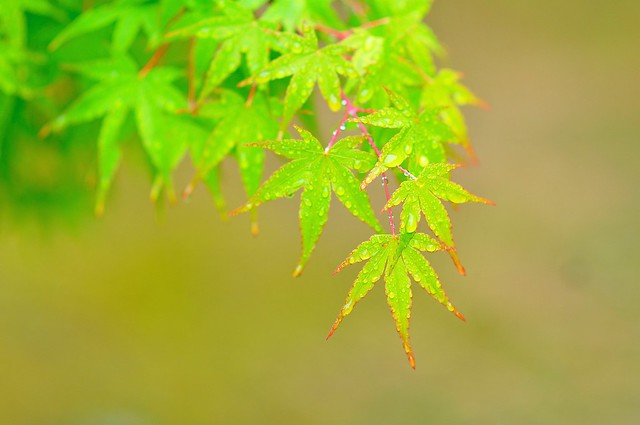 |
| Maple leaves. |
 |
| A temple lurks behind the main path. |
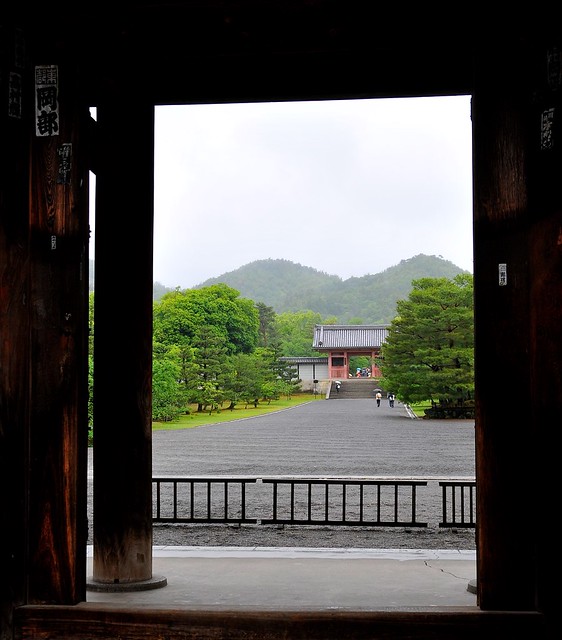 |
| Leaving through the main gate. |
Myoshinji temple complex
The
Myoshinji zen temple complex is a collection of almost 50 sub-temples arranged around a main temple. Each of the sub-temples is surrounded by a wall, and the complex is almost like a subdivision: there are alleys and pathways leading to the individual sub-temples, each of which has its own entrance gate. You can freely roam the pathways and visit the main temple, but the sub-temples that allow visitors each tend to charge about ¥500 for admittance.
Compared to the main sites like Ryoanji and Kinkakuji, Myoshinji is an exercise in tranquility and solitude. You will see few other tourists, and you'll have the time and space to soak in the atmosphere.
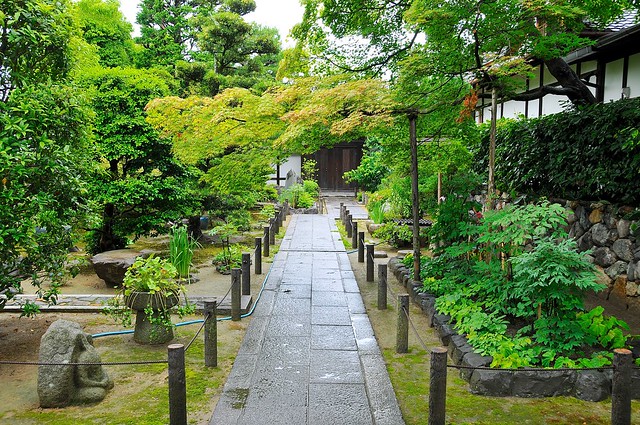 |
| Entrance to a sub-temple. |
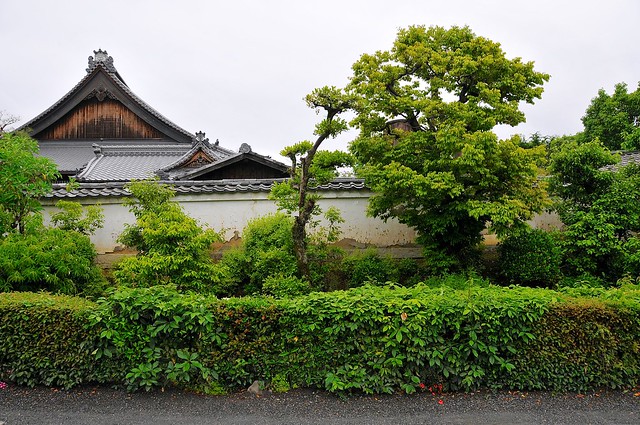 |
| Sub-temple walls seen from one of the complex's main paths. |
 |
| A temple's bamboo grove lurks behind its wall. |
 |
| Pathway leading to sub-temple. |
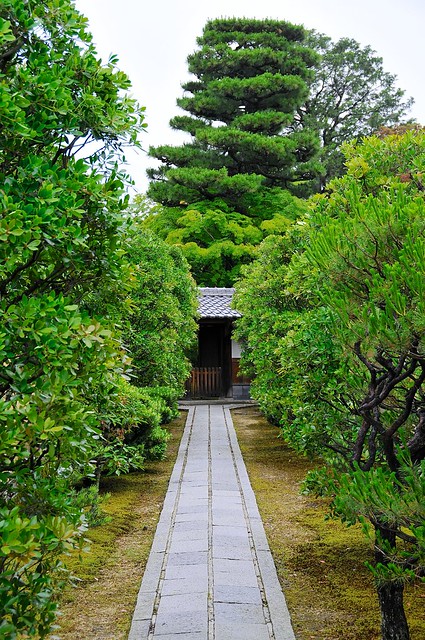 |
| Some temples have entrances right off the main path, others have their own pathways leading to them. |
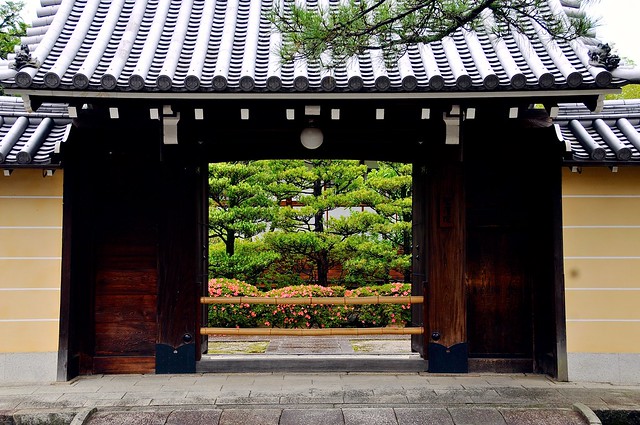 |
| Most sub-temples are closed to the public. |
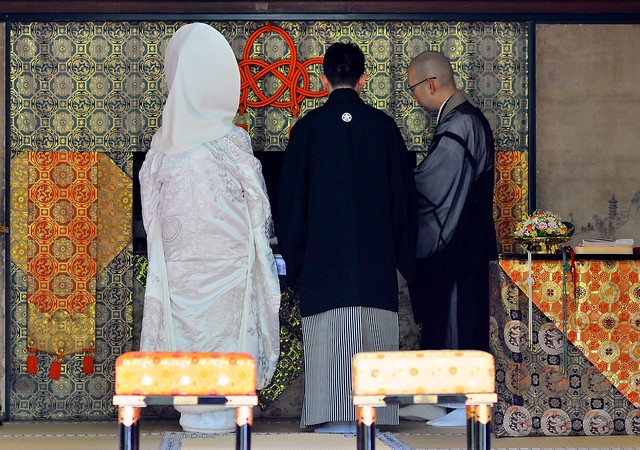 |
| Taizoin temple
is famous for its zen rock gardens. When I was there, there were wedding
rites being performed in the temple proper. It's unusual for a wedding to
be performed at a Buddhist temple, as wedding ceremonies are typically
Shinto. |
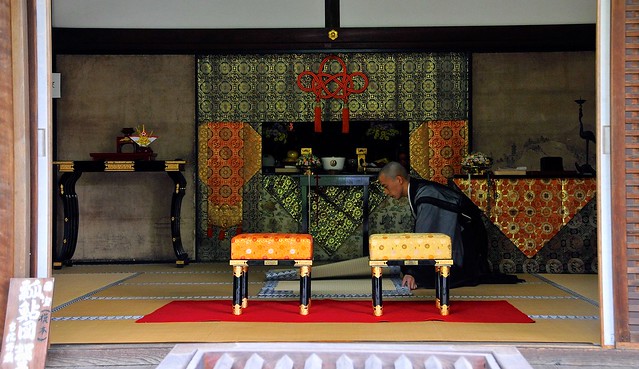 |
| The monk making preparations for the ongoing ceremonies. |
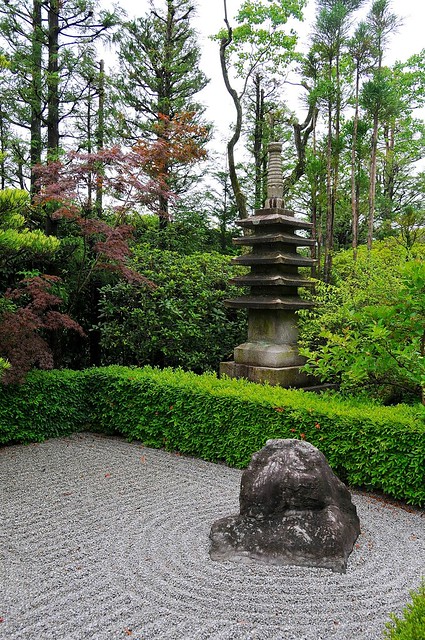 |
| Taizoin zen rock garden. |
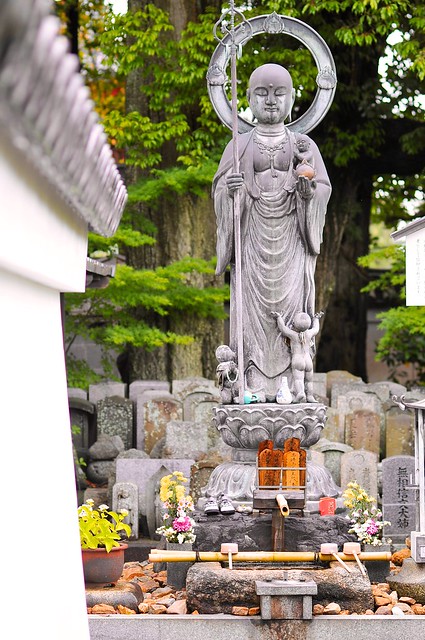 |
| The temple's cemetery. |
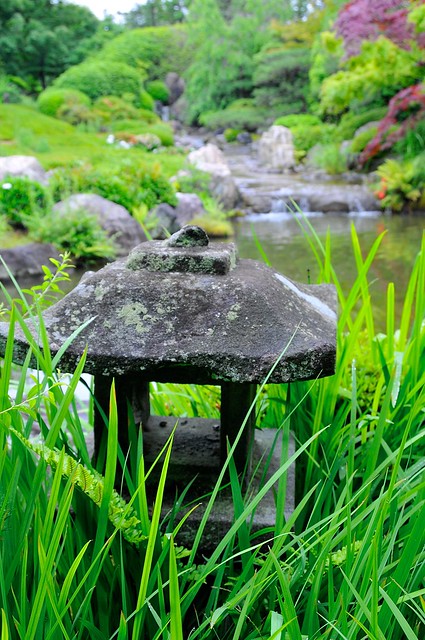 |
| The rear garden at Taizoin. |
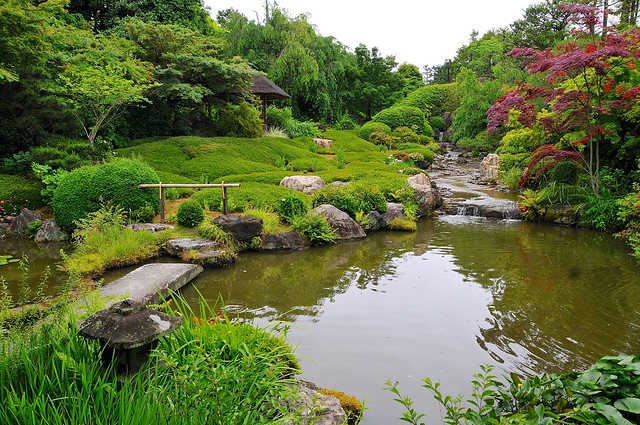 |
| You would never know Taizoin is so large from its unassuming entrance gate. |
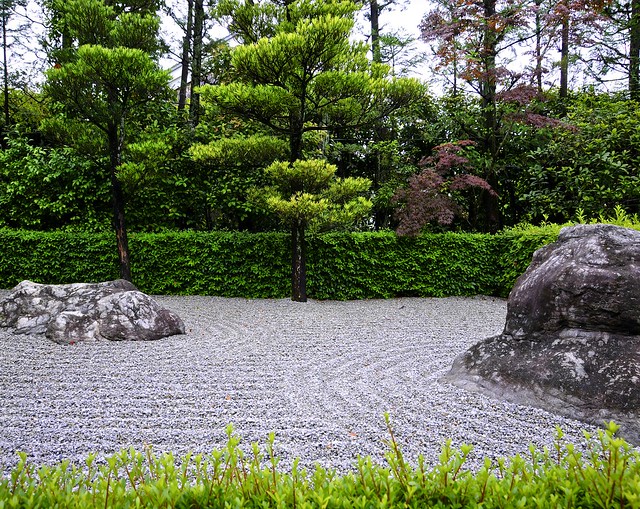 |
| More of the rock garden. |
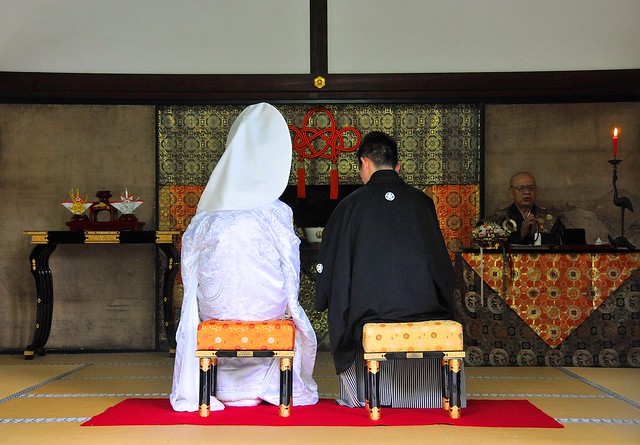 |
| An hour later, the wedding ceremonies continued. |
Gion
Gion is the traditional entertainment district of Kyoto. Today, it is lined with traditional buildings and restaurants, and has narrow brick streets.
 |
| Maiko (apprentice Geisha) on her way to an appointment. |
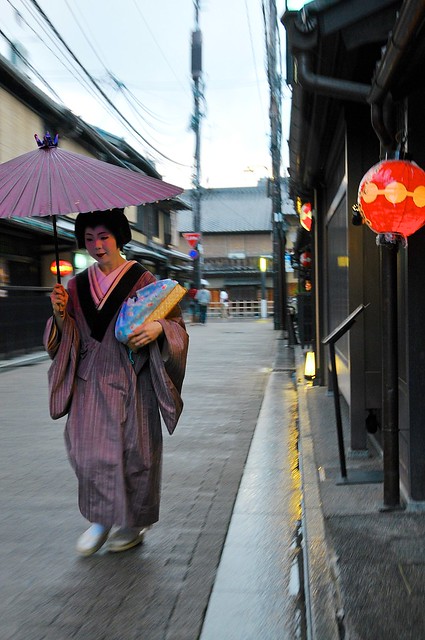 |
| Geisha are by no means common, but Gion is probably your best bet to see them in the wild. |
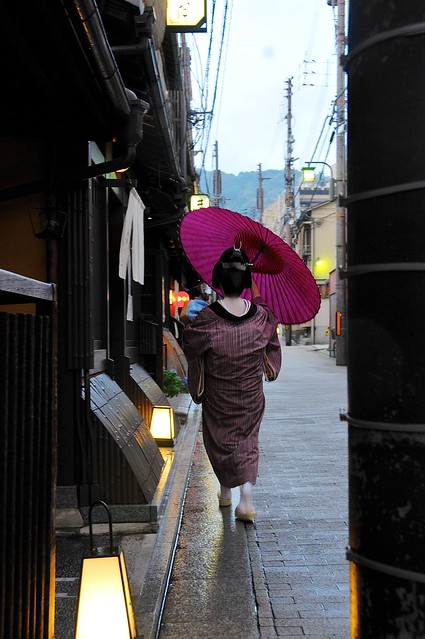 |
| Tourists must be very annoying, even if Geisha are too genteel to show it. |
 |
| Maiko returning from an appointment. |
Day two: Daitokuji, Entsuji, northern Kyoto, and the eastern slopes.
On my second day I cycled past Ninnaji, Ryonaji, and Kinkakuji on my way to Daitokuji, stopping at the nearby Imamiya jinja shrine (following the route suggested in the map above).
 |
View of Daimonjiyama from near Daitokuji. The kanji on the mountain, 大, means large. There are five characters like this on the hills around Kyoto, and at the end of the O-bon Buddhist ancestor-worship holiday they are set on fire. |
Daitokuji
Daitokuji is the other large zen temple complex in Kyoto, and it is quite similar to Myoshinji: a number of small sub-temples connected by paths and alleys around a few large temple buildings. As with Myoshinji, entry to the complex and many of the main buildings is free, but the sub-temples that accept visitors charge about ¥500 each.
Daitokuji is more central to Kyoto, and more easily accessible from popular sights like the Imperial Palace and Kinkakuji, so it gets more visitors than Myoshinji... but remains tranquil in comparison to other popular places.
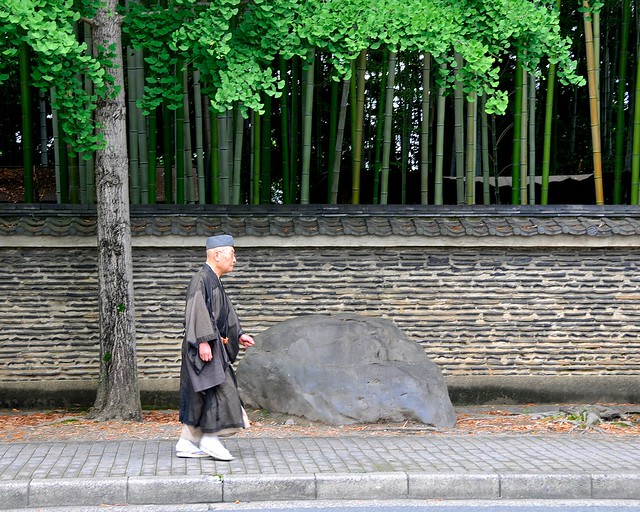 |
Monk walking by the external wall of Daitokuji.
|
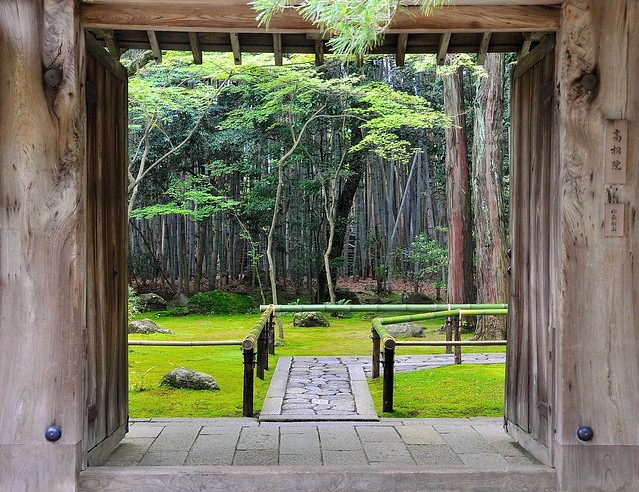 |
An entrance gate at Daitokuji.
|
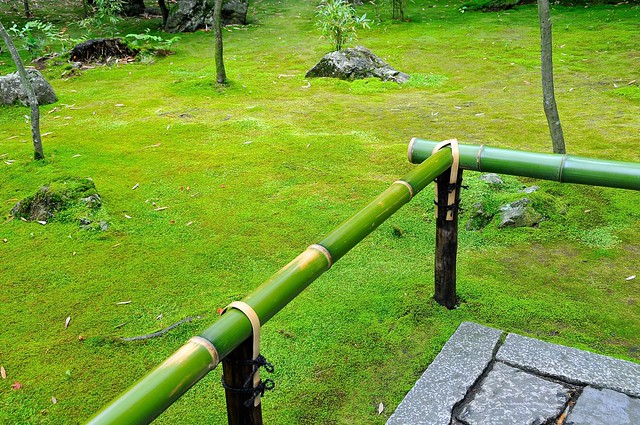 |
Moss behind a bamboo fence.
|
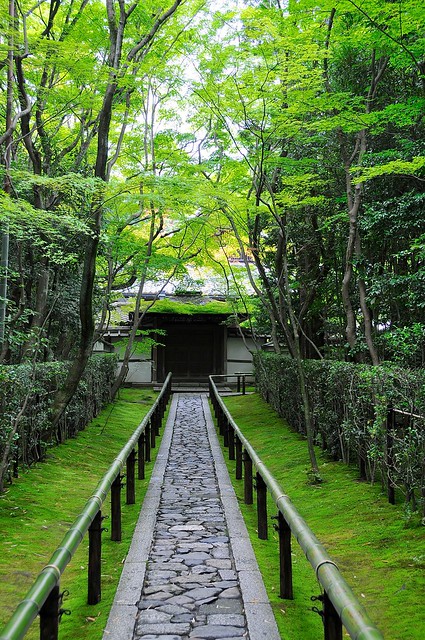 |
Lush green moss and coordinating bamboo fencing flanks this temple path.
|
 |
The moss to this temple is brown, and so is the bamboo and hemp fencing.
|
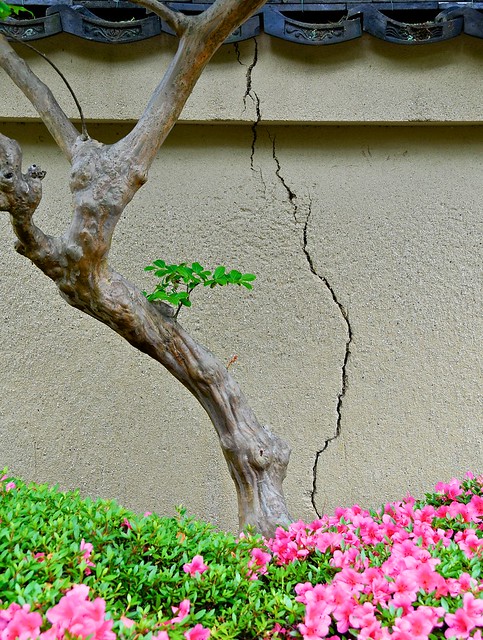 |
A tree trunk and bright pink blossoms in front of a temple wall.
|
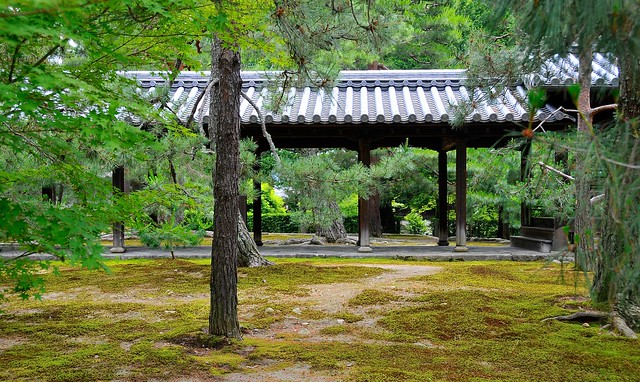 |
A covered pathway leads to one of the main Daitokuji buildings.
|
 |
Pine branches in front of a temple wall.
|
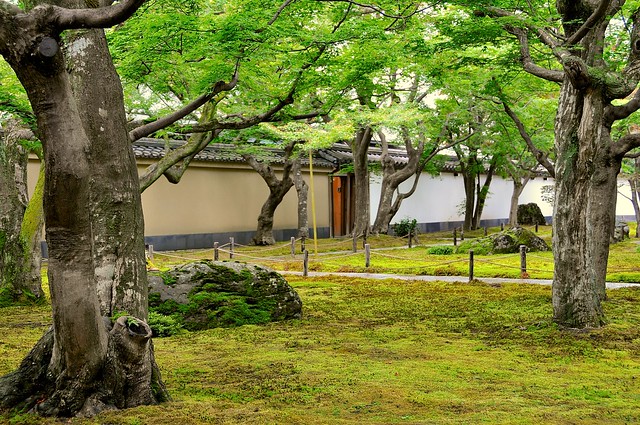 |
The path meanders through a mossy yard.
|
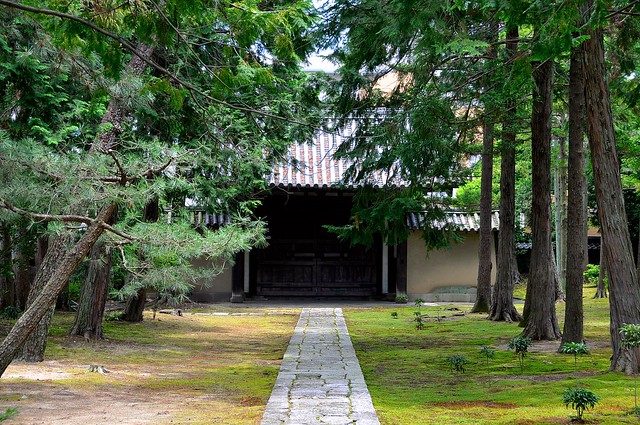 |
Dry ground on the north, damp on the south.
|
Entsuji & northern Kyoto
From Daitokuji I again followed the trail in the map above. It's a pleasant ride. Just before reaching Entsuji, you go through up a steep and narrow road, and might think you're not on the right track, but you are.
In all honesty,
Entsuji is something of a one-trick pony: it offers a superb view from the main temple chamber, with a mossy garden in the foreground, and a row of trees framing the mount Hiei across the valley. It's a pretty great trick. This use of the distant Hiei makes Entsuji a "borrowed view" garden. Because of the limited appeal of Entsuji, as well as its admission price, not a lot of people go there (or stay long). It's a great place to take a break and sit and read while taking in the view.
Photography of the building interiors is not allowed, nor are tour guides.
 |
The entrance to the temple.
|
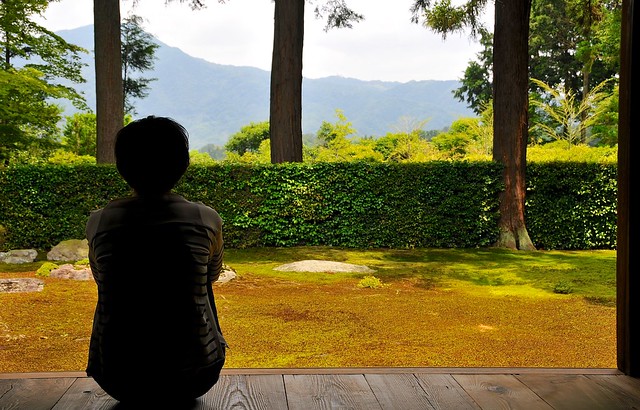 |
Admiring the view.
|
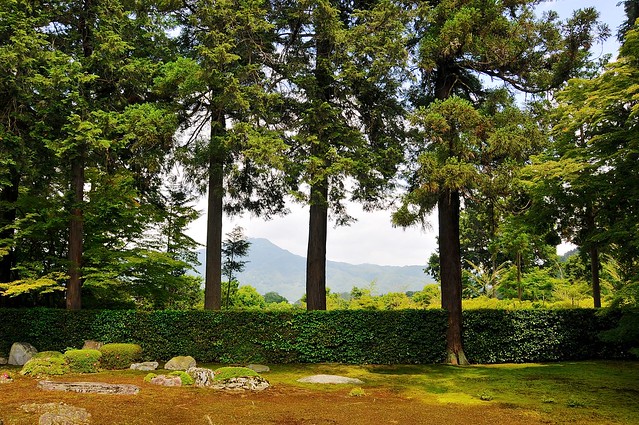 |
The wide view.
|
 |
I suppose there things other than Mount Heian to look at, too.
|
Entsuji is a gateway to northern Kyoto, which is largely isolated from the rest of the city by mountains. The northern area has an even more relaxed feeling than the rest of the city, as well as a few temples/shrines.
 |
On the streets north of Entsuji, again looking towards Hiei.
|
 |
Myomanji
temple has a replica of the stupa from Bodh Gaya, India, where Buddha
gained enlightenment. It also has a garden for which an admittance fee
is charged.
|
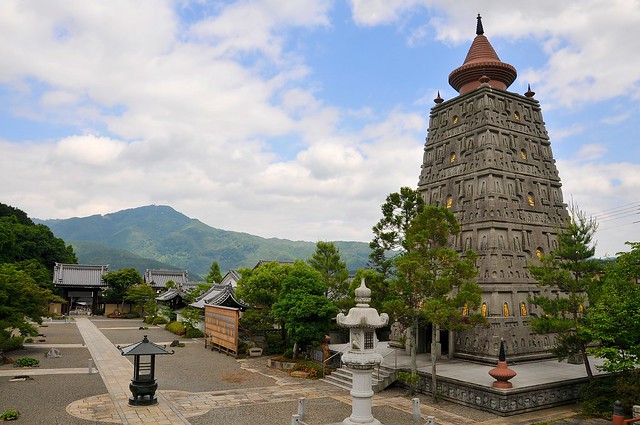 |
Mount Hiei in the background.
|
The Kyoto International Convention Center has some interesting walkways and koi ponds next to the larger Takaragaike pond. There's a pleasant park around Takaragaike pond. Instead of heading south from there, as in the mapped route, I headed east towards the base of the cable-car to Mount Hiei. There are a few small, local temples and shrines along the road leading to the cable-car station.
The eastern mountains, from Mount Hiei south.
From the cable-car station, I headed south, following the slope of the mountains, staying as high up (and as close to any temples or shrines) as possible.
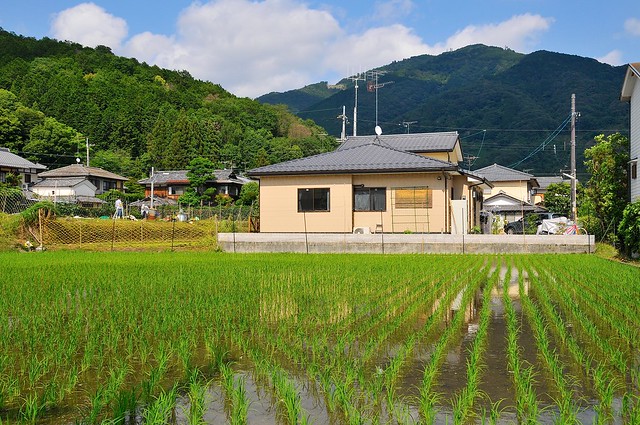 |
The sorts of suburban fields and
rice paddies, small as they are, are common in Japan. Protectionist
trade tariffs and large subsidies makes even this level of micro-farming
a worthwhile endeavor. When I lived in Wakayama my apartment building was surrounded by small rice paddies.
|
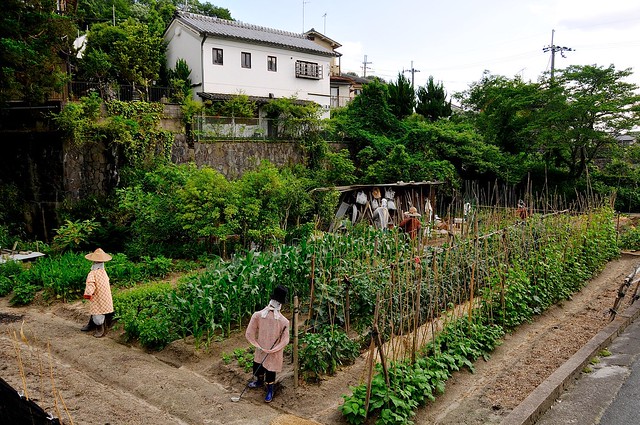 |
Scarecrows protect the crops.
|
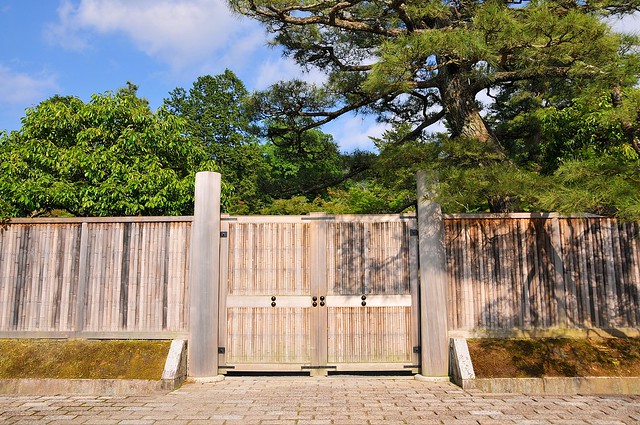 |
The entrance gate to the Shugakuin Imperial Villa.
|
 |
A stone lantern at Bentendo shrine.
|
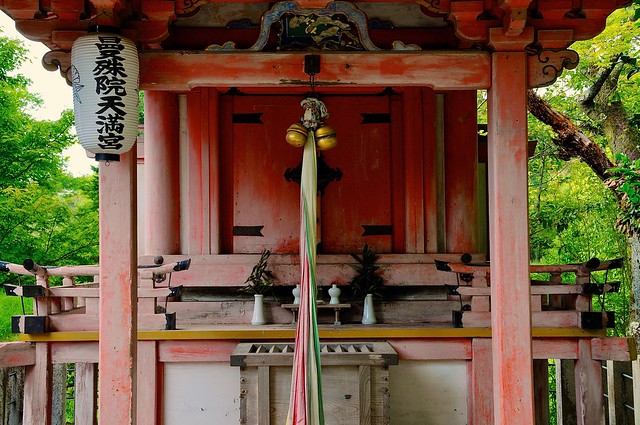 |
An altar at Bentendo shrine.
|
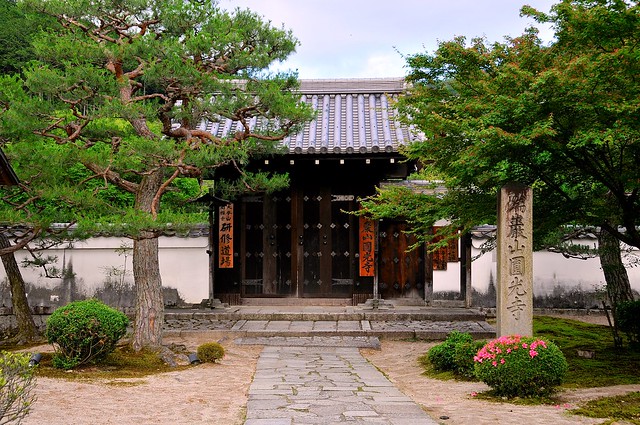 |
The gate to Enkoji temple.
|
 |
| This is the eastern version of Daimonjiyama, with the same 大 ("big") character: Hidari ("left-hand") Daimonjiyama. |
 |
| Shinnyodo temple and pagoda from Yoshidayama park. |
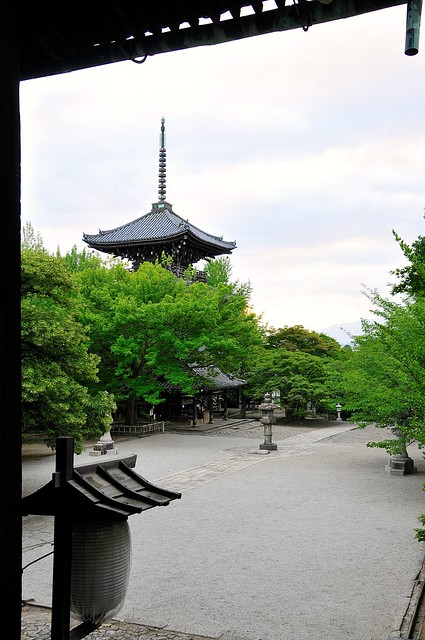 |
| Shinnyodo pagoda from the temple. |
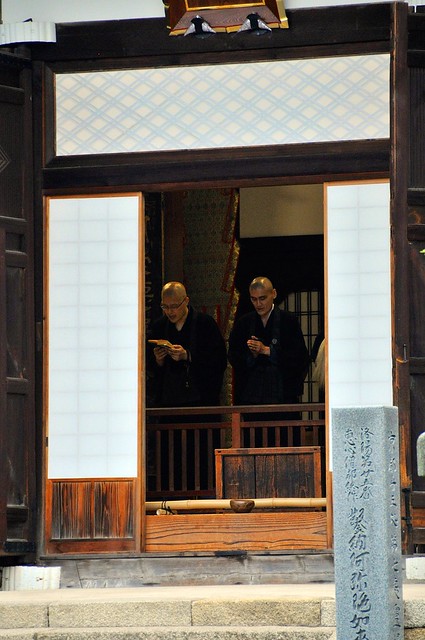 |
| Monks chanting in Kurodani temple at dusk. |
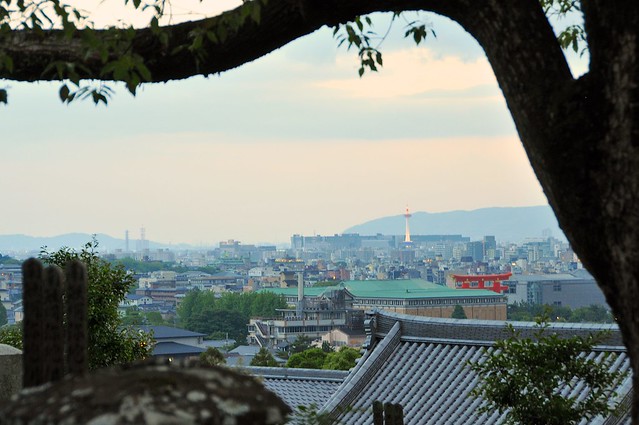 |
| From Kurodani pagoda you can see part of Heian
jinja shrine's great tori (one of the largest in Japan), Kyoto tower, and the
train station in the distance. |
 |
| This is as close as you can get to Kiyomizudera temple at night: ropes and a security guard ensure you don't enter. |
 |
| Gion restaurant. |
 |
| On the bike ride back to Utano I passed this rather unfortunately-named restaurant. This says something about the general level of cultural
awareness and sensitivity in Japan. |






























































No comments:
Post a Comment